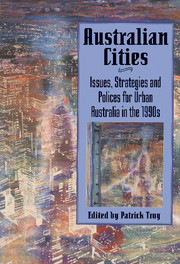Book contents
- Frontmatter
- Contents
- List of Figures
- List of Tables
- Preface
- Acknowledgements
- Note on Contributors
- Abbreviations
- Introduction
- Part I The Development and State of Australian Cities
- Part II Current Policies and Options
- 5 The Battle for Balmain
- 6 State Planning Operation
- 7 Planning in a Multicultural Environment: A Challenge for the Nineties
- 8 Local Government and the Urban Growth Debate
- 9 Towards More Equitable Cities: A Receding Prospect?
- Part III Avenues for Development
- References
- Index
7 - Planning in a Multicultural Environment: A Challenge for the Nineties
Published online by Cambridge University Press: 03 May 2011
- Frontmatter
- Contents
- List of Figures
- List of Tables
- Preface
- Acknowledgements
- Note on Contributors
- Abbreviations
- Introduction
- Part I The Development and State of Australian Cities
- Part II Current Policies and Options
- 5 The Battle for Balmain
- 6 State Planning Operation
- 7 Planning in a Multicultural Environment: A Challenge for the Nineties
- 8 Local Government and the Urban Growth Debate
- 9 Towards More Equitable Cities: A Receding Prospect?
- Part III Avenues for Development
- References
- Index
Summary
‘In those Local Government Areas in which immigrants are concentrated, Local Government's response to immigrant needs has, with a few exceptions, been slow and uneven. Many Local Governments recognise this and generally perceive the problem to be sourced in financial constraints.’ This evaluation of immigration and local government budgets (Cutts 1992:xii) is supported by the concurrent evaluation of immigration on State government budgets: ‘the present financial capacity of State governments is not adequate to provide education, housing and other services on the scale needed by many immigrants if they are to be fully integrated into Australian society’ (Mathews 1992:xxiv). At a higher level, the Commonwealth government and its policies of fiscal restraint are blamed. Yet it is recognised by both documents that immigrants from non-English speaking backgrounds (NESBs) contribute more to government budgets than they claim back.
This purely financial outlook is a common rationale for limited action on social or urban issues, including planning which addresses multicultural issues. Making sure migrants, new and old, receive a ‘fair go’ is more often seen in the light of the goals of a democratic, interesting, vibrant country. While Australian popular opinion varies, often in direct relation to the strength of the economy, some level of immigration has been accepted by both parties.
- Type
- Chapter
- Information
- Australian CitiesIssues, Strategies and Policies for Urban Australia in the 1990s, pp. 164 - 178Publisher: Cambridge University PressPrint publication year: 1995
- 6
- Cited by



